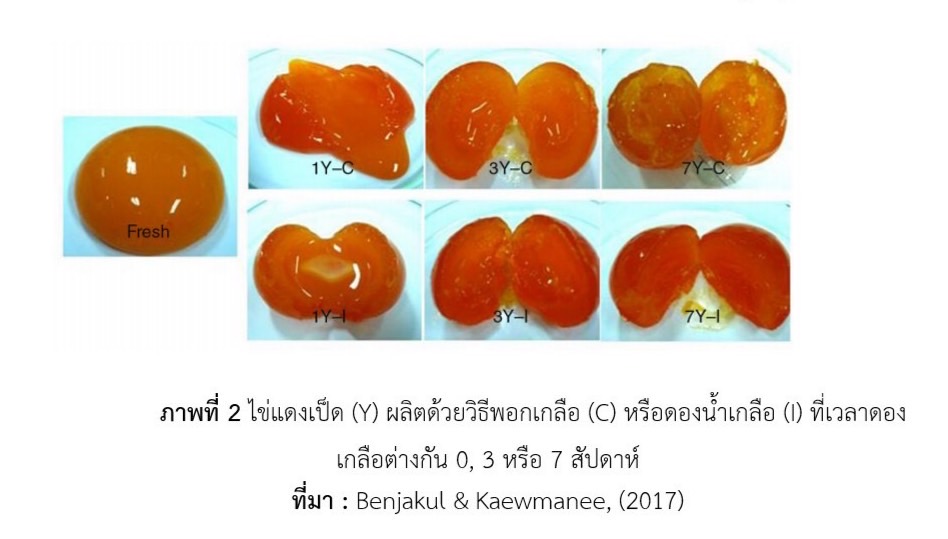กระบวนการผลิตและการพัฒนากระบวนการผลิตภัณฑ์ไข่เค็ม
Main Article Content
บทคัดย่อ
ไข่เค็มนิยมรับประทานเป็นอาหารโดยเฉพาะกับข้าวต้มหรือโจ๊ก ส่วนไข่แดงเค็มอาจใช้เป็นส่วนผสมในผลิตภัณฑ์ขนมอบและเบเกอรี่ เช่น ขนมไหว้พระจันทร์หรือขนมเปี๊ยะ การดองเกลือเป็นวิธีที่ใช้ในการผลิตไข่เค็ม โดยทั่วไปคุณภาพของไข่เค็มขึ้นอยู่กับความเข้มข้นของน้ำเกลือ ระยะเวลาในการดองเกลือ วิธีการทำไข่เค็ม และสารทำให้เกิดออสโมติกในน้ำเกลือ ดังนั้นการรวบรวมข้อมูลที่เกี่ยวข้องกับวิธีการผลิตไข่เค็มรวมถึงการพัฒนากระบวนการผลิตเพื่อวัตถุประสงค์ต่าง ๆ เช่น ลดเวลาในการผลิต ลดต้นทุนการผลิต ลดการสูญเสียไข่ขาว ลดปริมาณโซเดียมหรือเกลือในการผลิตไข่เค็มโซเดียมสำหรับผู้บริโภคที่มีภาวะเสี่ยงต่อโรคไต และการเพิ่มสารชีวภาพที่ออกฤทธิ์ยับยั้งการเจริญเติบโตของจุลินทรีย์ เป็นต้น โดยการดองแบบดั้งเดิมที่นำไข่สดทั้งลูกไปดองในน้ำเกลือ และแบบการดองเฉพาะไข่แดงในน้ำเกลือปกติ และใส่สารช่วยออสโมติก เพื่อเพิ่มประสิทธิภาพในการกำจัดน้ำด้วยแรงออสโมติกและลดระยะเวลาในการดอง ซึ่งส่งผลคุณภาพทางด้านกายภาพและเคมีของไข่เค็มที่ผลิตได้ ทำให้ไข่เค็มที่ผลิตได้มีการเปลี่ยนแปลงองค์ประกอบทางเคมี รวมถึงคุณภาพด้านกายและเคมีไข่เค็มที่ส่งผลต่อลักษณะเนื้อสัมผัสอย่างชัดเจน ซึ่งข้อมูลเหล่านี้สามารถนำมาใช้ในการพัฒนาผลิตภัณฑ์ไข่เค็มตามความต้องการของผู้บริโภคกลุ่มต่าง ๆ ต่อไป โดยการควบคุมปัจจัยต่าง ๆ ที่เกี่ยวข้องกับการผลิตเพื่อให้สามารถลดเวลาและต้นทุนการผลิตไข่เค็มที่มีคุณภาพตามที่ต้องการได้
Article Details
เอกสารอ้างอิง
กาญจนิจ กณิถอนันต์. (2515). การหาเปอร์เซ็นต์เกลือในไข่ดองเค็ม. [ปัญหาพิเศษปริญญาโท]. มหาวิทยาลัยเกษตรศาสตร์.
ศูนย์วิทยาศาสตร์และวัฒนธรรมเพื่อการศึกษาร้อยเอ็ด. (2564, 30 มกราคม). กล่องความรู้ สะเต็มศึกษาสู่อาชีพ เรื่อง การย่นระยะการดองไข่เค็ม. หน้า 6. https://pubhtml5.com/qwis/fwwt/basic
Benjakul, S. and Kaewmanee, T. (2017). Chapter 39: Sodium Chloride Preservation in Duck Eggs. In: Patricia Hester, editors: Egg Innovation and Strategies for Improvement, Oxford: Academic Press; 2017, pp. 415-426. https://doi.org/10.1016/B978-0-12-800879-9.00039-1
Chen, X.D., Y. Freeman, F. Guo & P. Chen. (1999). Diffusion of sodium chloride through chicken eggshell in relation to an ancient method of egg preservation. Food Bioproducts Process, 77(C1), 40-46. https://doi.org/10.1205/096030899532240
Chi, S-P. & Tseng, K. H. (1998). Physicochemical properties of salted pickled yolks from duck and chicken eggs. Journal of Food Science, 63(1), 27-30. https://doi.org/10.1111/j.1365-2621.1998.tb15668.x
Davidson, P.M., (2001). Chemical preservatives and natural antimicrobial compounds. In: Doyle, M.P.,
Beauchat, L.R., Montville, T.J. (Eds.), Food Microbiology: Fundamentals and Frontiers. DC: ASM Press, Washington, D.C., United States, pp. 117–126.
Foegeding, E.A., Davis, J.P., Doucet, D., & McGuffey, M.K. (2001). Advances in modifying and understanding whey protein functionality. Trends in Food Science & Technology, 13, 151–159. https://doi.org/10.1016/S0924-2244(02)00111-5
Harrison, L.J., & Cunningham, F.E., (1986). Influence of frozen storage time on properties of salted yolk and its functionality in mayonnaise. Journal of Food Quality, 9, 167–174. https://doi.org/10.1111/j.1745-4557.1986.tb00786.x
Harlina, P. W., Hu, M. M., Legowo, A. M., & Pramono, Y. B. (2012). The effect of supplementation garlic oil as an antibacterial activity and salting time on the characteristics of salted egg. Jurnal Aplikasi Teknologi Pangan, 1(4).
Kaewmanee, T., Benjakul, S., & Visessanguan, W. (2011). Effect of NaCl on thermal aggregation of egg white proteins from duck egg. Food Chemistry. 125(2), 706–712. https://doi.org/10.1016/j.foodchem.2010.09.072
Kaewmanee, T., Benjakul, S., Visessanguan, W. and Gamonpilas, C. (2013). Effect of sodium chloride and osmotic dehydration on viscoelastic properties and thermal-induced transitions of duck egg yolk. Food and Bioprocess Technology, 6, 367-376. https://doi.org/10.1007/s11947-011-0667-7
Kaewmanee, T., Benjakula, S. & Visessanguan, W. (2009). Effect of salting processes on chemical composition, textural properties and microstructure of duck egg. Journal of science food agriculture, 89, 625–633. https://doi.org/10.1111/j.1750-3841.2010.01975.x
Kiosseoglou, V.D. (2003). Egg yolk protein gels and emulsions. Current Opinion in Colloid & Interface Science, 8, 356–370. https://doi.org/10.1016/S1359-0294(03)00094-3
Kiosseoglou, V.D., & Sherman, P. (1983). The rheological conditions associated with judgment of pourability and spreadability of salad dressing. Journal of Texture Studies, 14, 277–282. https://doi.org/10.1111/j.1745-4603.1983.tb00350.x
Kunkriangwong, J., Tuitemwong, P., Saengdarerat, R., Phattarapanyakul, W., Kansup, W., Suntornsuk, W., (2002). Production of salty eggs using hydrostatic pressure. The Proceedings of 40th Kasetsart University Annual Conference. Kasetsart University, Bangkok, Thailand, 4–7 February 2002.
Lai, K.-M., Chi, S.-P., & Ko, W.-C. (1999). Changes in yolk states of duck egg during long-term brining. Journal of Agricultural and Food Chemistry. 47(2), 733–736. https://doi.org/10.1021/jf980486r
Lian, Z., Qiao, L., Zhu, G., Deng, Y., Qian, B., Yue, G., Zhao, Y., (2014). Use of sodium dodecyl sulfate pretreatment and 2-stage curing for improved quality of salted duck eggs. Journal of Food Science, 79, 354–361. https://doi.org/10.1111/1750-3841.12361
Novia, D., Melia, S., & Juliyarsi, I. (2014). Utilization of ash in the salting process on mineral content raw salted eggs. Asian Journal of Poultry Science. 8, 1–8. https://doi.org/10.3923/ajpsaj.2014.1.8
Puppo, M.C., & Anon, M.C. (1999). Soybean protein dispersions at acid pH: thermal and rheological properties. Journal of Food Science, 64, 50–56. https://doi.org/10.1111/j.1365-2621.1999.tb09859.x
Saeaung, W., Laoharatanahirun, A., Boonyaprapasorn, A. & Thipayarat, A. (2010). Novel processing of salted yolk production using separated yolk brining methodology. Food Innovation Asia Conference: Indigenous Food Research and Development to Global Market, June 17–18, BITEC, Bangkok, Thailand.
Shiquan, W., Shucai, W., Yipeng, Z., & Rong, Z. (2013). Parameter optimization for quickly salted egg by using ultrasonic–pulsed pressure technology. Transactions of the Chinese Society of Agricultural Engineering, 29, 286–292. https://doi.org/10.3969/j.issn.1002-6819.2013.23.039
Wang, C.T. (1991). The physical-chemical properties of salted egg yolk during granulation or gelation process. Journal of the Chinese Chemical Society, 29, 406-414.
Wang, T.-H. (2017). Salting yolks directly using fresh duck egg yolks with salt and maltodextrin. Japan Poultry Science Association. 54(1), 97-102. https://doi.org/10.2141/jpsa.0160027
Wang, X., Gao, Z., Xiao, H., Wang, Y., & Bai, J. (2013). Enhanced mass transfer of osmotic dehydration and changes in microstructure of pickled salted egg under pulsed pressure. Journal of Food Engineering, 117(1), 141–150. https://doi.org/10.1016/j.jfoodeng.2013.02.013
Yang, S.C., & Chen, K.N. (2001). The oxidation of cholesterol in the yolk of selective traditional Chinese egg products. Poultry Science, 80(3), 370–375. https://doi.org/10.1093/ps/80.3.370
Yimtoe, S., Haruthaithanasan, Y., Rimkeeree, H. (2001). Development of low sodium salted eggs coated with rice straw pulp. The Proceedings of 39 thKasetsart University Annual Conference. Kasetsart University, Bangkok, Thailand, 5–7 February 2001.
Yuwawutto, S., (1995). The development of processed soil for salted egg processing. Master of Science Thesis. Kasetsart University, Bangkok, Thailand.


